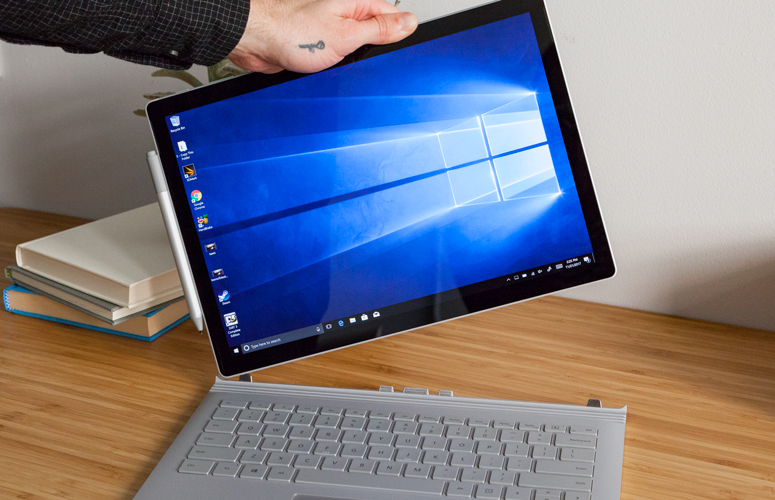Windows 10 S Will Become An 'S Mode' In All Windows 10 Versions (Updated)
Update, 3/7/18, 7:30pm PT: Microsoft posted more information on this matter, clarifying the questions we had. We adjusted the article to reflect that new information.
Microsoft corporate vice president Joe Belfiore confirmed on Twitter that Windows 10 S, a feature-locked version of Windows 10 that is limited to running UWP apps, is going to be replaced by an “S mode” that companies can decide to enable on their products.
Windows 10 S will end up as one of Microsoft’s shortest-lived OSes. The news of its dissolution comes less than a year from the OS’ announcement in mid-2017. Currently, Windows 10 S is a distinct version of Windows that has its own license. The license can be upgraded to a Windows 10 Pro license for free or a fee (depending on what the system OEM chooses to offer). Even then, the OS has been adopted only on a select few systems, such as Microsoft’s Surface Book and all of the announced Qualcomm-powered PCs, so it’s not exactly ubiquitous.
According to Belfiore, Windows 10 S’ functionality will be replicated in a special mode that will be available in all versions of Windows. This new “S mode” will presumably arrive with one of Windows 10’s bi-annual feature updates. Because its arrival will signal the end of Windows 10 S’ availability, we don’t know yet what it’ll mean for existing Windows 10 S license holders. It does mean that Windows 10 S is effectively done. Going forward, only Home, Pro, and Enterprise licenses will be sold.
Rumors of Microsoft’s decision to change Windows 10 S due to its unpopularity appeared earlier this year. The rumors stated that Microsoft wouldn’t actually be removing a paid-upgrade option from Windows 10 and instead would allow system OEMs to ship versions of Windows that are locked in “S mode.” These would be unlockable to a full version with a similar upgrade process. Belfiore stated in a blog post that this won’t be happening. System OEMs will be able to ship systems pre-toggled in “S mode,” but the user will be able to freely toggle out of it. Windows 10 Enterprise deployers will be able to lock their devices into “S Mode.”
All of this means that Windows 10’s marketing is about to get even more complicated. Microsoft is already asking customers to distinguish between Windows 10 on Arm and Windows 10 on X86. Things could get even more confusing once the company flips the switch to make “S mode” a feature instead of its own OS.
Get Tom's Hardware's best news and in-depth reviews, straight to your inbox.
-
Dosflores ReplyMicrosoft is already asking customers to distinguish between Windows 10 on Arm and Windows 10 on X86. Things could get even more confusing once the company flips the switch to make “S mode” a feature instead of its own OS.
I don't think this is going to be confusing to customers. It will be a pain only for IT staff.
Microsoft will only sell "Windows 10 Home" or "Windows 10 Pro". They won't sell "Windows 10 S" or "Windows 10 ARM" or "Windows 10 RT". A customer will only have to choose whether they want Pro features or not.
OEMs won't have to choose whether to enable S Mode or not. It will always be enabled by default. As soon as you try to install Chrome, you will be given the option to disable the S Mode:
WARNING: You're about to make your PC slower and less secure. Do you want to continue?
- No.
- Advanced options... (Run as Administrator required) -
237841209 I'd much rather prefer to see some sort of '7 Mode' or XP Mode again. (Since there's lack of support and major updates on either)Reply -
captaincharisma i wonder if this S Mode will be a free feature on pro editions that you can turn on and off at will. this would be great for security in the workplace. especially for computers open to the publicReply -
Ilya__ Reply20772806 said:i wonder if this S Mode will be a free feature on pro editions that you can turn on and off at will. this would be great for security in the workplace. especially for computers open to the public
I was thinking the same thing, like in public libraries, cafes and gyms.
-
Jagwired Windows 10 S might have been a more interesting product if they limited it to 64-bit apps only. If they could eliminate the 32-bit components of Windows, it would lower the storage size requirement for Windows and presumably improve security.Reply -
mihen Yea, I liked the idea of Windows 10 S because it would be difficult for people computer illiterate from giving away their savings accounts.Reply
